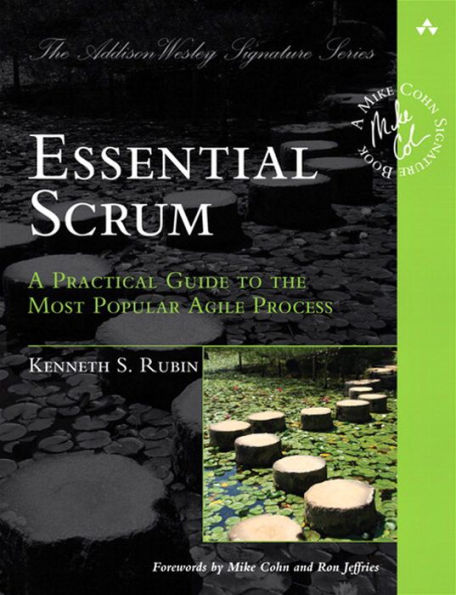Table of Contents
List of Figures xxv
Foreword by Mike Cohn xxxi
Foreword by Ron Jeffries xxxiii
Preface xxxv
Acknowledgments xxxix
About the Author xliii
Chapter 1: Introduction 1
What Is Scrum? 1
Scrum Origins 3
Why Scrum? 4
Genomica Results 4
Can Scrum Help You? 5
Closing 10
Part I: Core Concepts 11
Chapter 2: Scrum Framework 13
Overview 13
Scrum Roles 14
Scrum Activities and Artifacts 16
Closing 28
Chapter 3: Agile Principles 29
Overview 29
Variability and Uncertainty 32
Prediction and Adaptation 37
Just-in-Time Work 43
Validated Learning 44
Work in Process (WIP) 48
Progress 54
Performance 56
Closing 58
Chapter 4: Sprints 61
Overview 61
Timeboxed 62
Short Duration 64
Consistent Duration 67
No Goal-Altering Changes 69
Definition of Done 74
Closing 78
Chapter 5: Requirements and User Stories 79
Overview 79
Using Conversations 81
Progressive Refinement 82
What Are User Stories? 83
Level of Detail 86
INVEST in Good Stories 88
Nonfunctional Requirements 93
Knowledge-Acquisition Stories 93
Gathering Stories 95
Closing 98
Chapter 6: Product Backlog 99
Overview 99
Product Backlog Items 100
Good Product Backlog Characteristics 101
Grooming 104
Definition of Ready 108
Flow Management 110
Which and How Many Product Backlogs? 112
Closing 118
Chapter 7: Estimation and Velocity 119
Overview 119
What and When We Estimate 120
PBI Estimation Concepts 123
PBI Estimation Units 128
Planning Poker 129
What Is Velocity? 133
Calculate a Velocity Range 134
Forecasting Velocity 135
Affecting Velocity 135
Misusing Velocity 137
Closing 138
Chapter 8: Technical Debt 139
Overview 139
Consequences of Technical Debt 141
Causes of Technical Debt 144
Technical Debt Must Be Managed 148
Managing the Accrual of Technical Debt 149
Making Technical Debt Visible 153
Servicing the Technical Debt 155
Closing 162
Part II: Roles 163
Chapter 9: Product Owner 165
Overview 165
Principal Responsibilities 166
Characteristics/Skills 171
A Day in the Life 174
Who Should Be a Product Owner? 176
Product Owner Combined with Other Roles 181
Product Owner Team 182
Closing 184
Chapter 10: ScrumMaster 185
Overview 185
Principal Responsibilities 185
Characteristics/Skills 188
A Day in the Life 190
Fulfilling the Role 191
Closing 193
Chapter 11: Development Team 195
Overview 195
Role-Specific Teams 195
Principal Responsibilities 196
Characteristics/Skills 198
Closing 211
Chapter 12: Scrum Team Structures 213
Overview 213
Feature Teams versus Component Teams 213
Multiple-Team Coordination 218
Closing 223
Chapter 13: Managers 225
Overview 225
Fashioning Teams 227
Nurturing Teams 231
Aligning and Adapting the Environment 233
Managing Value-Creation Flow 235
Project Managers 237
Closing 243
Part III: Planning 245
Chapter 14: Scrum Planning Principles 247
Overview 247
Don’t Assume We Can Get the Plans Right Up Front 248
Up-Front Planning Should Be Helpful without Being Excessive 248
Keep Planning Options Open Until the Last Responsible Moment 249
Focus More on Adapting and Replanning Than on Conforming to a Plan 249
Correctly Manage the Planning Inventory 251
Favor Smaller and More Frequent Releases 252
Plan to Learn Fast and Pivot When Necessary 254
Closing 255
Chapter 15: Multilevel Planning 257
Overview 257
Portfolio Planning 259
Product Planning (Envisioning) 259
Release Planning 261
Sprint Planning 264
Daily Planning 264
Closing 265
Chapter 16: Portfolio Planning 267
Overview 267
Scheduling Strategies 270
Inflow Strategies 275
Outflow Strategies 280
In-Process Strategies 283
Closing 285
Chapter 17: Envisioning (Product Planning) 287
Overview 287
SR4U Example 290
Visioning 291
High-Level Product Backlog Creation 294
Product Roadmap Definition 295
Other Activities 298
Economically Sensible Envisioning 299
Closing 306
Chapter 18: Release Planning (Longer-Term Planning) 307
Overview 307
Release Constraints 311
Grooming the Product Backlog 315
Refine Minimum Releasable Features (MRFs) 316
Sprint Mapping (PBI Slotting) 316
Fixed-Date Release Planning 318
Fixed-Scope Release Planning 323
Calculating Cost 325
Communicating 326
Closing 330
Part IV: Sprinting 333
Chapter 19: Sprint Planning 335
Overview 335
Approaches to Sprint Planning 338
Determining Capacity 340
Selecting Product Backlog Items 343
Acquiring Confidence 344
Refine the Sprint Goal 346
Finalize the Commitment 346
Closing 346
Chapter 20: Sprint Execution 347
Overview 347
Sprint Execution Planning 349
Flow Management 349
Daily Scrum 354
Task Performance—Technical Practices 355
Communicating 356
Closing 360
Chapter 21: Sprint Review 363
Overview 363
Participants 364
Prework 365
Approach 368
Sprint Review Issues 372
Closing 373
Chapter 22: Sprint Retrospective 375
Overview 375
Participants 377
Prework 378
Approach 380
Follow Through 391
Sprint Retrospective Issues 392
Closing 393
Chapter 23: The Path Forward 395
There Is No End State 395
Discover Your Own Path 396
Sharing Best Practices 396
Using Scrum to Discover the Path Forward 397
Get Going! 398
Glossary 401
References 423
Index 427



